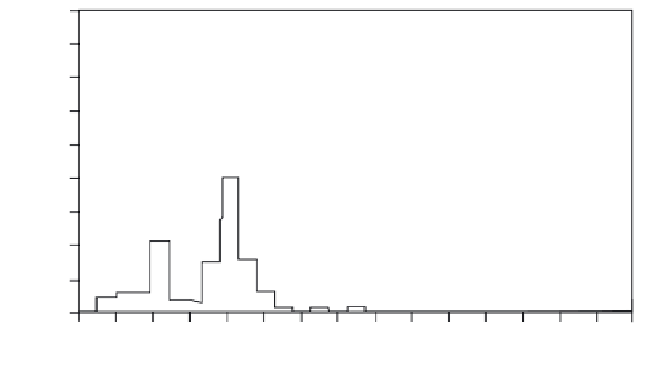Geoscience Reference
In-Depth Information
1800
River Kemijokki, Finland
1600
Chernobyl fallout
Fig. 4.15
Radiocaesium fallout
from the nuclear weapons test and
the Chernobyl accident on the
catchment area of River Kemijokki,
Finland (data from Ritva Saxen).
These data can be used for dating
lake sediments in this part of the
world. Note that in bioturbated
sediments, the age distribution at
various sediment depths in a
sediment core would be levelled out,
whereas in laminated sediments the
fallout peaks may be more easily
identified and the dating more exact.
1400
Nuclear weapons test fallout
1200
1000
800
600
400
200
0
1 25 49 73 97 121 145 169 193 217 241 265 289 313 337 361
1957 1959 1961 1963 1965 1969 1971 1973 1975 1977 1979 1981 1983 1983 1985 1987
Golterman et al. 1983; Jonsson 1992). This
section gives a brief discussion on methods to
determine ongoing sedimentation and the age
of recent sedimentary deposits and will not dis-
cuss palaeolimnological methods (such as pollen
analysis and the radiocarbon method; see Reeves
1968; Goudie 1981).
There are two very useful and widely applied
methods to determine the age of recent lake
sediments, lead-210 (
210
Pb) analysis (Robbins
1978; Appleby & Oldfleld 1979; Legesse et al.
2002) or the analysis of radiocaesium (
137
Cs;
see Pennington et al. 1973; Yan et al. 2002).
Lead-210 has a physical half-life of 22.3 years
and
137
Cs a half-life of 30.2 years, which makes
these substances very useful for dating recent
sedimentary deposits. To determine the sedi-
ment age using the
210
Pb method, one must also
quantify all fluxes from the catchment to the
lake, internal fluxes of
210
Pb (sedimentation and
resuspension) and lake outflow. This means that
mass-balance calculations are essential. Sedi-
ment dating using
137
Cs is simpler. For this, it is
important to have access to a fallout curve, such
as the one shown in Fig. 4.15 for a Finnish site.
Radiocaesium in western Europe has two basic
sources, fallout from the nuclear weapons test-
ing (mainly between 1957 and 1975) and the
Chernobyl accident (April-May 1986). By tak-
ing sediment cores and trying to identify these
peaks in radiocaesium activity/concentration, a
good estimate of the mean sedimentation rate and
the mean sediment age can be obtained. Evid-
ently, this method is more likely to give more
accurate estimates of sediment age in laminated
than in bioturbated sediments.
4.4.2 Sediment dating using sediment traps
Sedimentation and sediment age can also be
determined using sediment traps (see Håkanson
& Jansson 1983). Generally, sediment traps
are cylinders with a width:height ratio of 1:3
placed vertically in the water. Figure 4.16 gives
an example where sediment traps have been used
for sediment dating. From this figure, it is evid-
ent that the contamination of a river pollutant
(here mercury entering Lake Ekoln, Sweden, from
River Fyris) and the content of the contaminant
in lake sediments offer an excellent key to the
pollution history of the lake. In the same way,
the areal distribution pattern of the pollutant
in lake sediments can be used to evaluate trans-
port patterns in the system and to identify the
polluting site (or river).
4.5
MANAGEMENT AND REMEDIATION
4.5.1 Environmental consequence analysis and
ecosystem indices
In environmental management it is important
not to use personal viewpoints as criteria to rank


























